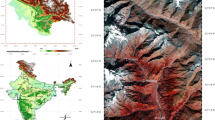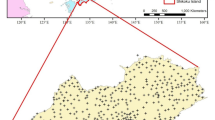Abstract
Digital elevation model (DEM) is the most popular product for three-dimensional (3D) digital representation of bare Earth surface and can be produced by many techniques with different characteristics and ground sampling distances (GSD). Space-borne optical and synthetic aperture radar (SAR) imaging are two of the most preferred and modern techniques for DEM generation. Using them, global DEMs that cover almost entire Earth are produced with low cost and time saving processing. In this study, we aimed to assess the Satellite pour l’observation de la Terre-5 (SPOT-5), High Resolution Stereoscopic (HRS), the Advanced Space-borne Thermal Emission and Reflection Radiometer (ASTER), and the Shuttle Radar Topography Mission (SRTM) C-band global DEMs, produced with space-borne optical and SAR imaging. For the assessment, a reference DEM derived from 1:1000 scaled digital photogrammetric maps was used. The study is performed in 100 km2 study area in Istanbul including various land classes such as open land, forest, built-up land, scrub and rough terrain obtained from Landsat data. The analyses were realized considering three vertical accuracy types as fundamental, supplemental, and consolidated, defined by national digital elevation program (NDEP) of USA. The results showed that, vertical accuracy of SRTM C-band DEM is better than optical models in all three accuracy types despite having the largest grid spacing. The result of SPOT-5 HRS DEM is very close by SRTM and superior in comparison with ASTER models.
Similar content being viewed by others

References
Aguilar F J, Mills J P, 2008. Accuracy assessment of lidar-derived digital elevation models. Photogrammetric Record, 23(122): 148–169. doi: 10.1111/j.1477-9730.2008.00476.x
Aguilar F J, Mills J P, Delgado J et al., 2010. Modelling vertical error in Lidar-derived digital elevation models. ISPRS Journal of Photogrammetry and Remote Sensing, 65(1): 103–110. doi: 10.1016/j.isprsjprs.2009.09.003
ASPRS (American Society of Photogrammetry and Remote Sensing), 1990. Accuracy standards for large scale maps. Photogrammetric Engineering and Remote Sensing, 56(7): 1068–1070.
Bahuguna I M, Kulkarni A V, 2005. Application of digital elevation model and orthoimages derived from IRS-1C Pan stereo data in monitoring variations in glacial dimensions. Journal of the Indian Society of Remote Sensing, 33(1): 107–112.
Baldi P, Bonvalot S, Briole P et al., 2002. Validation and comparison of different techniques for the derivation of digital elevation models and volcanic monitoring (Vulcano Island, Italy). International Journal of Remote Sensing, 23(22): 4783–4800. doi: 10.1080/01431160110115861
Baudoin A, Schroeder M, Valorge C et al., 2003. The HRS SAP initiative: A scientific assessment of the High Resolution Stereoscopic instrument on board of SPOT 5 by ISPRS investigators. ISPRS Hannover Workshop, High Resolution Mapping from Space, 4–6 October, Hannover, Germany. (on CDROM)
Betts H D, Trustrum N A, de Rose R C, 2003. Geomorphic changes in a complex gully system measured from sequential digital elevation models, and implications for management. Earth Surface Processes and Landforms, 28(10): 1043–1058. doi: 10.1002/Esp.500
Bolstad P V, Stowe T, 1994. An evaluation of DEM Accuracy: Elevation, slope and aspect. Photogrammetric Engineering and Remote Sensing, 60(11): 1327–1332.
Bullard J E, White K, Livingstone I, 2011. Morphometric analysis of aeolian bedforms in the Namib Sand Sea using ASTER data. Earth Surface Processes and Landforms, 36(11): 1534–1549. doi: 10.1002/Esp.2189
Bureau of the Budget, U.S., 1947. United States National Map Accuracy Standards (NMAS). Washington, D.C. Available at http://nationalmap.gov/standards/pdf/NMAS647.pdf
Carvalho O, Guimaraes R, Freitas L et al., 2010. Urbanization impacts upon catchment hydrology and gully development using mutli-temporal digital elevation data analysis. Earth Surface Processes and Landforms, 35(5): 611–617. doi: 10.1002/Esp.1917
Chang L D, Slatton K C, Krekelera C, 2010. Bare-earth extraction from airborne LIDAR data based on segmentation modelling and iterative surface corrections. Journal of Applied Remote Sensing, 4(041884). doi: 10.1117/1.3491194
Cuartero A, Felicisimo A M, Ariza F J, 2005. Accuracy, reliability, and depuration of SPOT HRV and Terra ASTER digital elevation models. IEEE Transactions on Geoscience and Remote Sensing, 43(2): 404–407. doi: 10.1109/Tgrs.2004.841356
Day D, Jacobsen K, Passini R et al., 2013. A study on accuracy and fidelity of terrain reconstruction after filtering DSMs produced by aerial images and airborne Lidar surveys. ASPRS 2013, 24–28 March, Baltimore Maryland, USA. (on CDROM)
DeLong S B, Prentice C S, Hilley G E et al., 2012. Multitemporal ALSM change detection, sediment delivery, and process mapping at an active earthflow. Earth Surface Processes and Landforms, 37(3): 262–272. doi: 10.1002/Esp.2234
E D C, Zhou C X, Liao M S, 2004. Application of SAR interferometry on DEM generation of the Grove Mountains. Photogrammetric Engineering and Remote Sensing, 70(10): 1145–1149.
Erdogan M, 2007. Investigation of Digital Elevation Model Standards According to Source and Quality of Data and Production Method. Institute of Science and Technology, Istanbul Technical University, Istanbul.
Esirtgen F, 2011. Quality Assessment and Accuracy Analysis of Digital Elevation Models. Institute of Science and Technology, Yildiz Technical University, Istanbul.
FEMA Appendix A, 2003. Guidance for Aerial Mapping and Surveying. Guidelines and Specifications for Flood Hazard Mapping Partners, Federal Emergency Management Agency.
FGDC, 1998. National Standards for Spatial Data Accuracy. U.S. Federal Geographic Data Committee, U.S.A.
Gianinetto M, 2009. Influence of the elevation accuracy in the updating of large scale geo-databases in mountain urban areas using IKONOS images. Journal of Applied Remote Sensing, 3(033536). doi: 10.1117/1.3169524
Heckmann T, Bimbose M, Krautblatter M et al., 2012. From geotechnical analysis to quantification and modelling using Li-DAR data: A study on rockfall in the Reintal catchment, Bavarian Alps, Germany. Earth Surface Processes and Landforms, 37(1): 119–133. doi: 10.1002/Esp.2250
Hladik C, Alber M, 2012. Accuracy assessment and correction of a LIDAR-derived salt marsh digital elevation model. Remote Sensing of Environment, 121: 224–235. doi:10.1016/j.rse.2012.01.018
Hobi M L, Ginzler C, 2012. Accuracy assessment of digital surface models based on WorldView-2 and ADS80 stereo remote sensing data. Sensors, 12(5): 6347–6368. doi: 10.3390/S120506347
Hohle J, Hohle M, 2009. Accuracy assessment of digital elevation models by means of robust statistical methods. ISPRS Journal of Photogrammetry and Remote Sensing, 64(4): 398–406. doi: 10.1016/j.isprsjprs.2009.02.003
Hu P, Liu X H, Hu H, 2009. Accuracy assessment of digital elevation models based on approximation theory. Photogrammetric Engineering and Remote Sensing, 75(1): 49–56.
Jacobsen K, 2003. DEM Generation from Satellite Data. EARSeL Workshop, 5–7 June, Ghent, Belgium, pp. 273–276.
Jacobsen K, 2012. Program System BLUH (User Manual). Institute of Photogrammetry and GeoInformation, Leibniz University Hannover, Germany. (unpublished)
Jia X, Richards J A, 1994. Efficient maximum likelihood classification for imaging spectrometer data sets. IEEE Transactions on Geoscience and Remote Sensing, 32(2): 274–281.
Kaczynski R, Majde A, Ewiak I, 2004. Accuracy of DTM and Ortho generated from Ikonos Stereo Images. ISPRS Congress, Geo-Imagery Bridging Continents, Istanbul. (on CDROM)
Lee H Y, Kim T, Park W et al., 2003. Extraction of digital elevation models from satellite stereo images through stereo matching based on epipolarity and scene geometry. Image and Vision Computing, 21(9): 789–796. doi: 10.1016/S0262-8856(03)00092-1
Li R, Zhou G, Schmidt N J et al., 2002. Photogrammetric processing of high-resolution airborne and satellite linear array stereo images for mapping applications. International Journal of Remote Sensing, 23(20): 4451–4473. doi: 10.1080/01431160110107662
Li Z, 1994. A comparative study of the accuracy of digital terrain models (DTMs) based on various data models. ISPRS Journal of Photogrammetry and Remote Sensing, 49(1): 2–11. doi: 10.1016/0924-2716(94)90051-5
Ma R J, 2005. DEM generation and building detection from Lidar data. Photogrammetric Engineering and Remote Sensing, 71(7): 847–854.
Martino C, Nico G, Schiattarella M, 2009. Quantitative analysis of InSAR digital elevation models for identification of areas with different tectonic activities in southern Italy. Earth Surface Processes and Landforms, 34(1): 3–15. doi: 10.1002/Esp.1681
Maune D F, 2007. Digital elevation model technologies and applications. The DEM User’s Manual, 2nd Edition. American Society for Photogrammetry and Remote Sensing, USA.
Michalis P, Dowman I, 2004. A rigorous model and DEM generation for SPOT-5 RS. ISPRS Congress, Geo-Imagery Bridging Continents, Istanbul. (on CDROM)
Munyati C, 2004. Use of principal component analysis (PCA) of remote sensing images in wetland change detection on the Kafue Flats, Zambia. Geocarto International, 19: 11–22.
NDEP (National Digital Elevation Program), 2004. Guidelines for Digital Elevation Data (Version 1.0). National Digital Elevation Program (NDEP). Available at DIALOG. http://www.ndep.gov/NDEP_Elevation_Guidelines_Ver1_10May2004.pdf
Radhadevi P V, Solanki S S, Nagasubramanian V et al., 2010. New era of Cartosat satellites for large scale mapping. Photogrammetric Engineering and Remote Sensing, 76(9): 1031–1039.
Schneider A, Gerke H H, Maurer T et al., 2012. Evaluation of remotely-sensed DEMs and modification based on plausibility rules and initial sediment budgets of an artificially-created catchment. Earth Surface Processes and Landforms, 37(7): 708–725. doi: 10.1002/Esp.2274
Sefercik U G, 2012. Performance estimation of ASTER global DEM depending upon the terrain inclination. Journal of the Indian Society of Remote Sensing, 40(4): 565–576. doi: 10.1007/s12524-012-0202-y
Sefercik U G, Alkan M, 2009. Advanced analysis of differences between C and X bands using SRTM data for mountainous topography. Journal of the Indian Society of Remote Sensing, 37(3): 335–349. doi: 10.1007/s12524-009-0044-4
Sefercik U G, Jacobsen K, 2006. Analysis of SRTM height models. Fifth International Symposium Turkish-German Geodetic Days, Technical University, Berlin. (on CDROM)
Sefercik U G, Soergel U, 2010. Comparison of High Resolution InSAR and Optical DEMs. EARSeL Joint SIG Workshop, Ghent. (on CDROM)
Shan J, Sampath A, 2005. Urban DEM generation from raw lidar data: A labeling algorithm and its performance. Photogrammetric Engineering and Remote Sensing, 71(2): 217–226.
Soergel U, Michaelsen E, Thiele A et al., 2009. Stereo analysis of high-resolution SAR images for building height estimation in case of orthogonal aspect directions. ISPRS Journal of Photogrammetry and Remote Sensing, 64(5): 490–500.
Soergel U, Thoennessen U, Stilla U, 2003. Visibility Analysis of Man-made Objects in SAR Image. IEEE/ISPRS Joint Workshop on Remote Sensing and Data Fusion over Urban Areas, Urban 2003, pp. 120–124.
Toutin T, 2002. DEM from stereo Landsat 7 ETM+ data over high relief areas. International Journal of Remote Sensing, 23(10): 2133–2139. doi: 10.1080/01431160110098005
Toutin T, 2008. ASTER DEMs for geomatic and geoscientific applications: A review. International Journal of Remote Sensing, 29(7): 1855–1875. doi: 10.1080/01431160701408477
Yastikli N, 2009. Digital Elevation Models Lecture Notes. Department of Geomatic Engineering, Yildiz Technical University, Istanbul. (In Turkish)
Yastikli N, Jacobsen K, 2003. Automatic digital elevation model generation, problems and restrictions in urban areas. Journal of Yildiz Technical University, 2003(2): 38–46.
Yastikli N, Toth C, Grejner-Brzezinska D A, 2007. In-situ camera and boresight calibration with LiDAR Data, Proc. The Fifth International Symposium on Mobile Mapping Technology, MMT’07, Padua. (on CDROM)
Zhao S M, Cheng W M, Zhou C H et al., 2011. Accuracy assessment of the ASTER GDEM and SRTM3 DEM: An example in the Loess Plateau and North China Plain of China. International Journal of Remote Sensing, 32(23): 8081–8093. doi: 10.1080/01431161.2010.532176
Author information
Authors and Affiliations
Corresponding author
Additional information
Foundation item: Under the auspices of Scientific Research Project Coordinatorship of Yildiz Technical University, Turkey (No. 20100503KAP01)
Rights and permissions
About this article
Cite this article
Yastikli, N., Sefercik, U.G. & Esirtgen, F. Quantitative assessment of remotely sensed global surface models using various land classes produced from Landsat data in Istanbul. Chin. Geogr. Sci. 24, 307–316 (2014). https://doi.org/10.1007/s11769-014-0681-6
Received:
Accepted:
Published:
Issue Date:
DOI: https://doi.org/10.1007/s11769-014-0681-6



